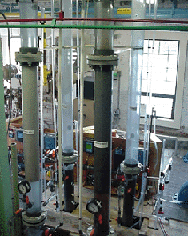Ozone vs. Hydrogen Peroxide (H2O2)/UV
Pretreatment
A side-by-side comparison between ozonation and H2O2/UV
pretreatment for slow sand filtration was evaluated in North Haven,
ME. The goal was to evaluate which preoxidation scheme would be
most efficient for reducing color and organic precursor material
in conjunction with slow sand filters.
Read
the Project Summary
Precoat and Ceramic Media Pressure Filtration Comparison - A Case
Study
This comparison was conducted in the Town of Jackson, NH. The
goal of the project was to assess non-chemical means of removing
protozoa sized particles. The challenge study employed turbidity
and Bacillus spore spiked source water for side-by-side comparison.
The results indicated no significant removal differences between
these filtration processes for this source water.
Read
the Project Summary
 Evaluation
of a New Method for Ozone Addition using Super Saturated Solutions
of Ozonated Water
Evaluation
of a New Method for Ozone Addition using Super Saturated Solutions
of Ozonated Water
This pilot study was conducted at the Town of Newmarket, NH drinking
water treatment facility in cooperation with Dufresne
and Associates. The objective was to evaluate sidestream ozonation
alongside a pilot system mimicking the existing treatment plant.
Treatment objectives were to eliminate taste and odor, substantially
reduce disinfection by-products and chlorine demand in the distribution
system and oxidize iron and manganese for subsequent removal by
clarification.
Read
the Project Summary
Alternative Surrogates for Monitoring of Ultraviolet (UV) Disinfection Performance
The purpose of this project was to identify a physical, chemical, or biological parameter that is either naturally present in a drinking water supply or can be safely added and upon contact in the UV reactor will undergo a measurable change that can be related to UV reactor performance. The goal was to find a simple test procedure that operators can use everyday to verify UV disinfection performance. This research was being led by Dr. Jim Malley at the University of New Hampshire.
Evaluating Arsenic Removal Adsorbents
As of February 2002, the EPA enacted the Arsenic Rule that lowered
the allowable limit of arsenic in drinking water. Drinking water
treatment systems must be in compliance with the new rule by January
2006. This research project has evaluated various absorptive materials
including traditional media and innovative media and their effectiveness
in removing arsenic from water. Anion competition for arsenic
adsorption sites was also evaluated in order to optimize the adsorbent
selection process. Small systems will benefit from the evaluation
of adsorbents in regard to the potential use for their systems
and water quality conditions.
Read
the Project Summary
Enhanced Corrosion Control in Small Water Systems
using Calcium Silicate Contactors
This study will use laboratory column and full-scale field experiments
to investigate the feasibility and benefits of using calcium silicate
(wollastonite) as an alternative or supplement to limestone in
packed-bed contactors. Corrosion control performance will be evaluated
by measuring copper and lead uptake from sections of lead/tin
soldered copper tubing. The results of the study will be used
to modify the contactor design program DESCON. The principal investigator
for this project is Dr. Raymond Letterman at Syracuse University.
Read
the Project Summary
Post Treatment Aeration to Reduce DBP for Small Systems
In this study, bench- pilot- and full scale aeration assessments are undertaken in order to evaluate the importance and interaction of variables associated with Trihalomethane (THM) and specifically chloroform removal. The bench scale study will provide statistical analysis of the effects of water temperature, air temperature, concentration of THMs, number of diffusers, air flow rate and aeration time on percent removal of THMs for diffused aeration systems. During the pilot phase of the experiment, specific spray and diffused aeration devices will be evaluated and efficiency of removals for each device compared. Both mass transfer efficiencies and percent removal will be compared between the various diffused and spray aeration systems. A full scale field evaluation is also planned.
Evaluation and Optimization of an Intermittent SSF for Small Community and Non-Community Systems
The major goal of this study is to evaluate the removal of selected microorganisms in SSF systems operated intermittently and how such a system can be optimized. In addition to removal of bacteria and viruses, particular attention will be paid to the removal of Cryptosporidium oocyst surrogates, and if the 2.5-log removal credited to continuously operated SSF can be achieved. The completion of the proposed study will facilitate the application of log removal credits to intermittent biological filtration systems for satisfying the LT2ESWTR. A more detailed understanding of microbial removal by intermittent SSF systems may also contribute to a wider acceptance of these biological treatment methods by small systems.



